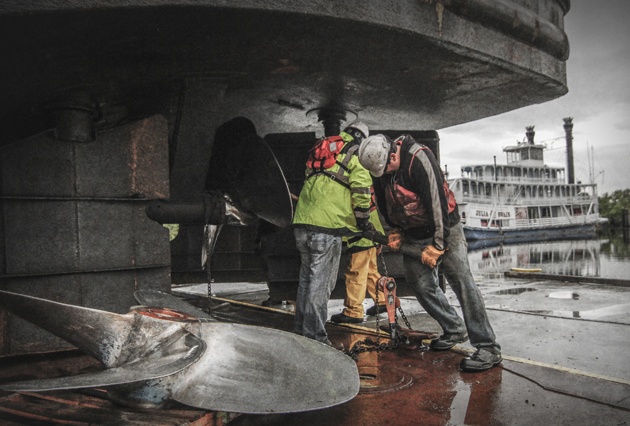Reliable Dock Repair Work Techniques: Making Sure Architectural Honesty
Guaranteeing the structural honesty of anchors with effective fixing strategies is vital for the durability and safety and security of aquatic facilities. Consequently, picking the right repair materials, such as composite materials and corrosion-resistant alloys, is vital for longevity.
Analyzing Dock Damages
Assessing dock damages is a critical first step in guaranteeing the structural stability and safety of any type of docking center. Trick facets to examine include the dock's foundation, pilings, outdoor decking, and hardware (Dock Repairs).
Structural engineers or certified examiners normally carry out these analyses utilizing specialized tools and techniques. Underwater inspections could utilize finder devices or from another location ran automobiles (ROVs) to detect submerged damages. Above water, aesthetic assessments are enhanced by making use of wetness meters and various other diagnostic tools to reveal underlying issues not immediately noticeable to the naked eye.

Picking Fixing Materials
Selecting the proper repair service products is a crucial step in the dock restoration procedure, one that straight influences the durability and efficiency of the repaired framework. Product selection need to be driven by factors such as ecological conditions, load-bearing requirements, and compatibility with existing dock elements.
Along with wood, composite materials are increasingly prominent as a result of their toughness and low upkeep requirements. Compounds, commonly made from a mix of plastic and timber fibers, offer superb resistance to rot, insects, and UV damage. For metal docks, picking corrosion-resistant alloys such as galvanized steel or marine-grade light weight aluminum is vital to stop rust and make certain architectural honesty in saline water problems.
Epoxy resins and marine-grade sealers are vital for fixing fractures and sealing joints, supplying a waterproof barrier and enhancing the dock's total strength. By thoroughly picking high-quality products, dock fixings can accomplish resilient results, thereby protecting against future destruction and ensuring secure, reliable usage.
Architectural Reinforcement Methods
Effective structural support strategies are important in guaranteeing the stability and longevity of dock fixings. This technique is especially reliable for docks exposed to hefty lots or extreme ecological conditions.
An additional crucial technique is the application of fiber-reinforced polymers (FRP) These products use high strength-to-weight proportions and excellent resistance to corrosion, making them excellent for reinforcing concrete or wood anchors. FRP can be applied in strips or sheets and bound with epoxy materials to improve structural stability.
Bracing and anchoring systems additionally play a vital duty in structural reinforcement. Cross-bracing, making use of metal or wood beam of lights, can neutralize side forces, decreasing persuading and activity. Securing systems, such as helical piers or driven stacks, offer a stable structure by moving tons to much deeper, more steady dirt layers.
Last but not least, the combination of load-distribution plates can help distribute weight more uniformly across the dock's surface area, mitigating localized anxiety factors. These strategies collectively make sure that docks continue to be safe and robust, capable of enduring the roughness of their operational atmosphere.
Advanced Fixing Approaches

An additional advanced technique entails underwater welding, which enables for fixings to be conducted without the demand to dewater the area. This approach is specifically advantageous for dealing with structural issues in submerged dock components, guaranteeing very little disturbance to procedures. Boosted welding techniques, combined with robotic systems, provide accuracy and reliability, consequently prolonging the lifespan of the dock.
Additionally, cathodic defense systems are try this web-site applied to stop corrosion in metal dock frameworks. By utilizing sacrificial anodes or amazed existing systems, these techniques properly reduce the electrochemical procedures that result in material deterioration.
Last but not least, advanced monitoring modern technologies, such as architectural health and wellness surveillance (SHM) systems, offer real-time data on the condition of dock frameworks. These systems allow positive maintenance and timely interventions, inevitably making sure the long-term structural integrity of the dock.
Upkeep and Avoidance
Maintenance and prevention are fundamental concepts that underpin the long life and security of dock structures. Normal assessments are critical, allowing for very early detection of deterioration, possible weaknesses, and ecological influences. An aggressive technique, entailing regular checks for rust, rot, and architectural shifts, mitigates pricey repairs and extends the dock's functional life.
Safety nets need to consist of using safety coverings to steel elements to safeguard against corrosion and using cured wood to stand up to decay. Furthermore, guaranteeing proper water drainage and ventilation can protect against water buildup, which is an usual cause of structural destruction. Incorporating high quality materials and sticking to maker standards throughout building and repair phases likewise play vital duties in boosting longevity.

Educating personnel in dock upkeep ideal techniques makes sure constant application of safety nets. Leveraging technical advances, such as drones for examinations and sensors for real-time monitoring, can additionally improve maintenance initiatives. By focusing on maintenance and avoidance, dock proprietors can make sure structural integrity, operational security, and cost-effective management over the dock's lifespan.
Final Thought
In verdict, keeping the structural stability of aquatic centers requires extensive dock repair work methods. Advanced repair service strategies, coupled with regular upkeep methods, guarantee the dock stays safe and functional under diverse ecological conditions.
Guaranteeing the structural honesty of docks with effective fixing strategies is vital for the longevity and security of marine facilities.Selecting the proper repair work materials is a pivotal step in the dock repair process, one that directly affects the long life and performance of the repaired framework.Effective architectural reinforcement techniques are essential in ensuring the stability and durability of dock repair work. By prioritizing maintenance and avoidance, dock proprietors can make sure architectural stability, functional security, and cost-effective management over the dock's life-span.
In final thought, keeping the structural honesty of aquatic facilities demands comprehensive dock repair work strategies.